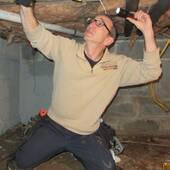Molds are a diverse group of fungi, a classification which also includes mushrooms and yeasts. When the average person thinks of the term mold he or she is usually referring to fungi that appear as powdery growths on food items or grow on moist areas of the home. Although viewed often as food spoilers they are natural organic decomposers.
If conditions are right a single mold spore can produce a fungal colony with hundreds of thousands of spores in 2-9 days. To grow a mold requires organic matter to eat and a moisture source. Most molds are not picky, they will grow on almost any organic matter. The moisture source can be in the form of almost any water source. Condensation, dampness, and humidity are all acceptable forms of moisture that will help mold grow. Most molds can live in humidity ranges from 0% to 100% but are most prolific in the 65% to 85% humidity range. The vast majority of allergenic molds release their spores into the atmosphere during dry conditions.
Allergy to mold is similar to other allergy in its symptoms and treatment. The major difference is that mold can be found both indoors and outdoors. Also the presence of mold spores does not have to do with the different seasons of the year. People who are allergic to molds may have symptoms that last for long periods of time and recur several times through the year.
For more information on mold and mold testing in New Jersey see the LookSmart New Jersey Mold Testing web sire.

Comments (1)Subscribe to CommentsComment